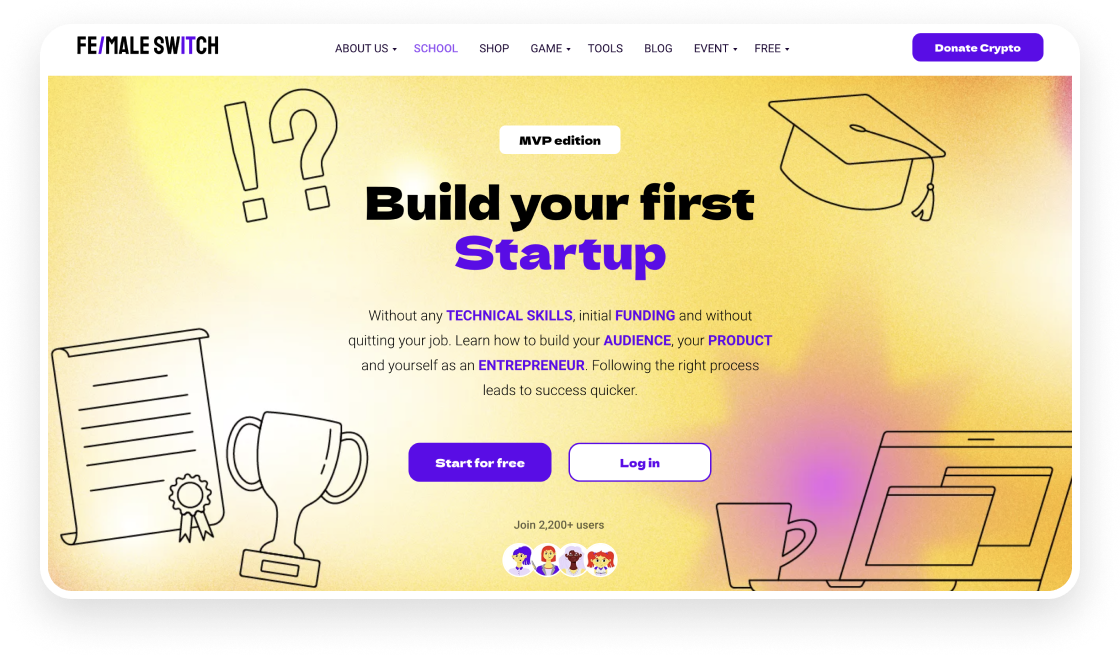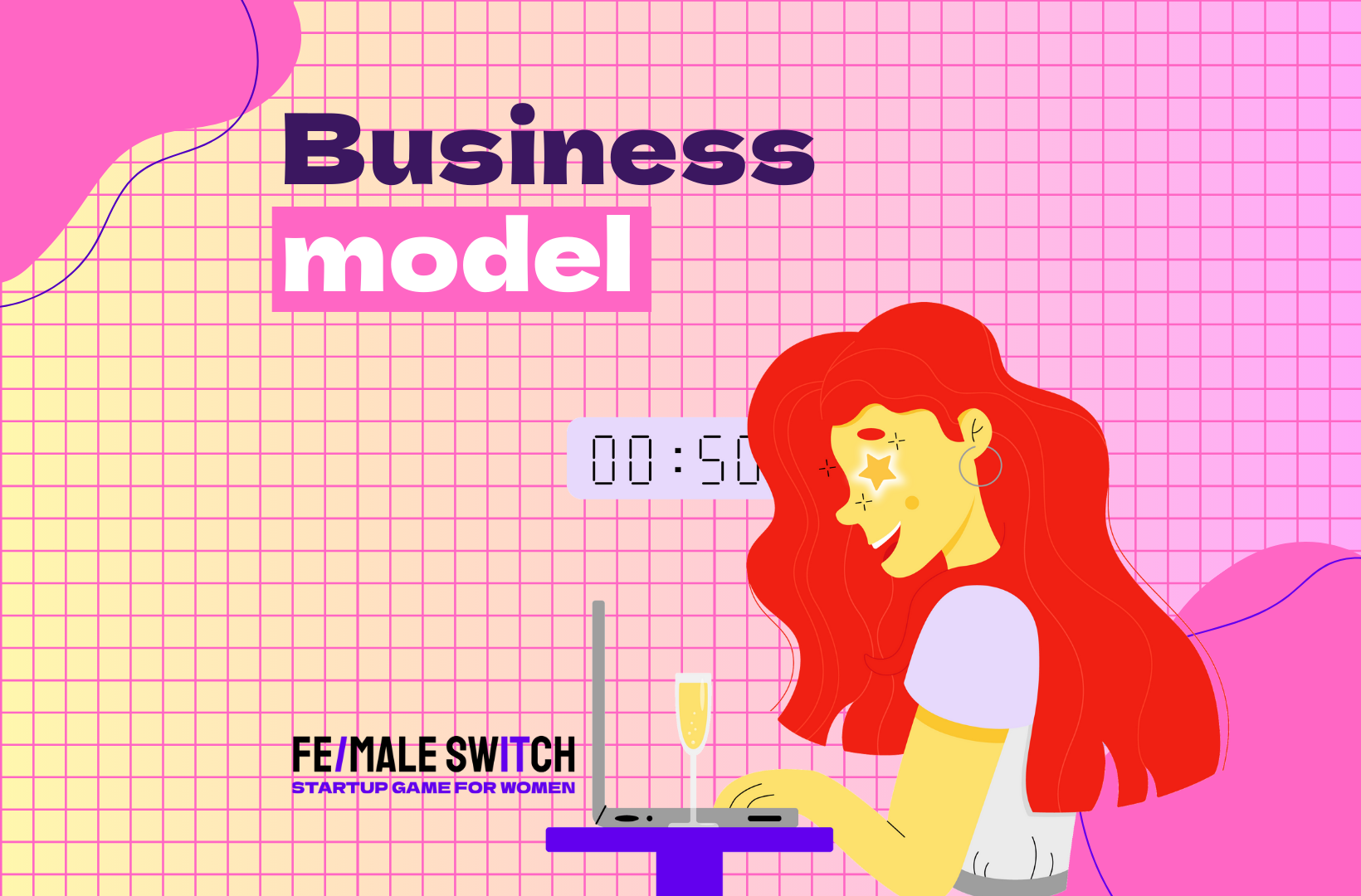Try our FREE AI Business Model Canvas generator to automatically create a BMC by answering just two questions 🔗here🔗
Do you have an urge to become an entrepreneur? (You might want to analyse your entrepreneurial potential here). That's a great start! For everything else, there's Elona, the AI startup co-founder for you! As your AI co-founder, Elona delivers a powerful combination of expertise, support, and motivation to help you conquer the world of startups.
An amazing startup idea got into your head but you’re struggling with validating it because you don't have enough data? Did you hear the magic word "canvas" but have no idea how to approach the beast? In general, canvases are awesome tools for brainstorming about your business that make you stay concise: they are a one page document. There are several well known canvases available: the Business Model Canvas, the Value Proposition Canvas, the Problem Statement Canvas, etc. Here's the link to the template in case you want to get started right away. But do read up for more advice.
In this article we will describe the Business Model Canvas in detail. We will not only give you a clearer picture of how to approach filling in the Business Model Canvas, but we will also share an editable template of the Business Model Canvas and tell you about our own canvas that we created for those who are not yet ready for the Business Model One.

We have a completely FREE STARTUP SCHOOL and there's a new AI FOR STARTUPS MODULE run by AI. Sign up for the free startup school and get started immediately.
TL;DR: Here's the BMC CREATOR that you can fill in using Canva (if you still don't use this tool, start immediately. It's going to change your life and it is free). If that template is too complicated for you because you don't have any data yet, start with the F/MS Canvas that we built specially for aspiring entrepreneurs like you.
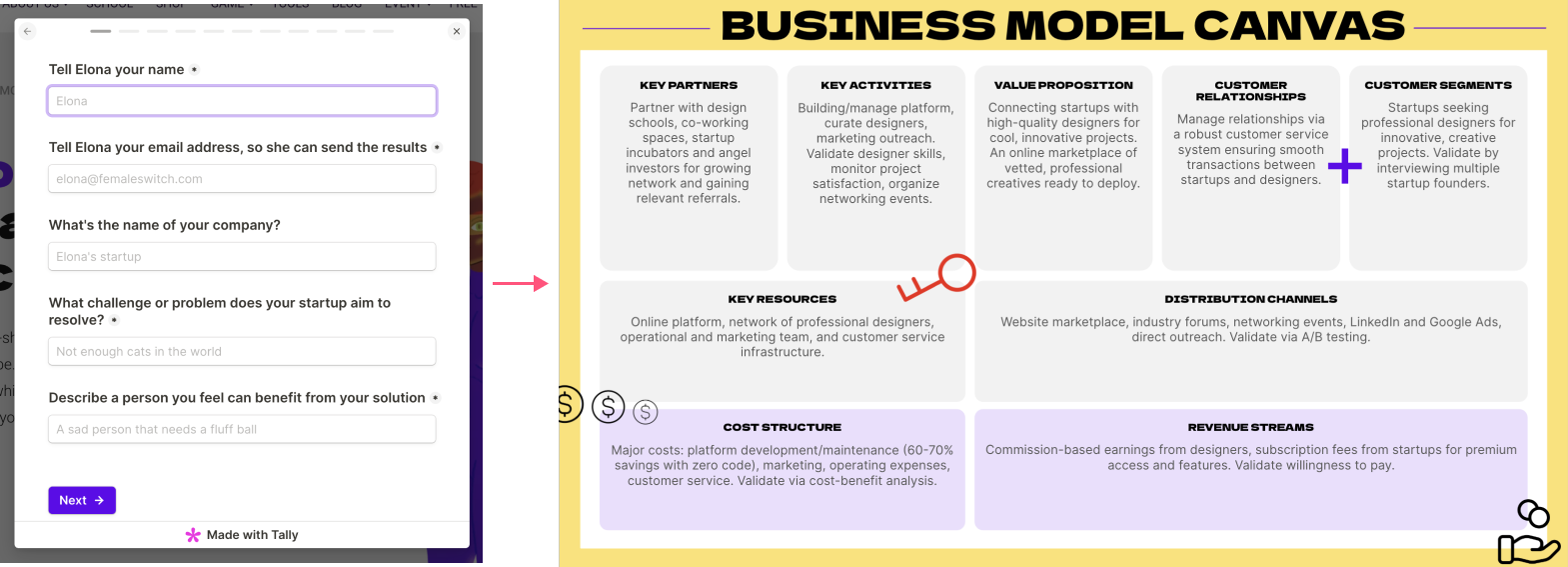
Why the business canvas is an important startup tool
Business Model Canvas is a great tool for startups because it helps them to quickly identify and document their business model. It allows them to visualize the different elements of their business model and to quickly identify any potential problems or areas for improvement. The canvas also helps startups to identify potential revenue streams and to understand the costs associated with their business model. This helps them to make informed decisions about their business model and to ensure that it is profitable.
What are the drawbacks?
One of the drawbacks of Business Model Canvas is that it can be difficult to accurately fill in all of the sections especially when you are just getting started. It is also difficult to accurately predict the future of the business model.
Additionally, the canvas does not provide any guidance on how to implement the business model and to measure its success. This can make it difficult to determine if the business model is sustainable or not. Finally, the canvas does not provide any guidance on how to scale the business model. This can make it difficult for startups to look at the growth potential of their business.
Join our Startup School and get access to our knowledge base!
What is the Business Model Canvas?
Business Model Canvas is a strategic management and lean startup template for developing new or documenting existing business models. It is a visual chart with elements describing a company’s or product’s value proposition, infrastructure, customers, and finances. It assists companies in aligning their activities by illustrating potential trade-offs.
The main purpose of a business canvas is to describe how your business intends to make money, which is the main goal of any business. Business canvases are great tools that allow you to effectively visualize and assess your business concept on a single page.
The business model canvas (BMC) contains nine boxes representing core elements of a business and may serve as an excellent pitch deck template to attract investors or talk to customers. The sections are: customer segments, value proposition, channels, customer relationships, revenue streams, key resources, key activities, key partners, and cost structure. Each section is filled in with information about the company’s business model.
A business model canvas template was developed by Alex Osterwalder and Yves Pigneur and introduced in the book “Business Model Generation” as a framework for planning and testing the business model of an organization.
The left side of the BMC focuses on your business and internal factors of your enterprise which you can control like Key Activities, Key Resources, Key Partners, and Cost Structure.
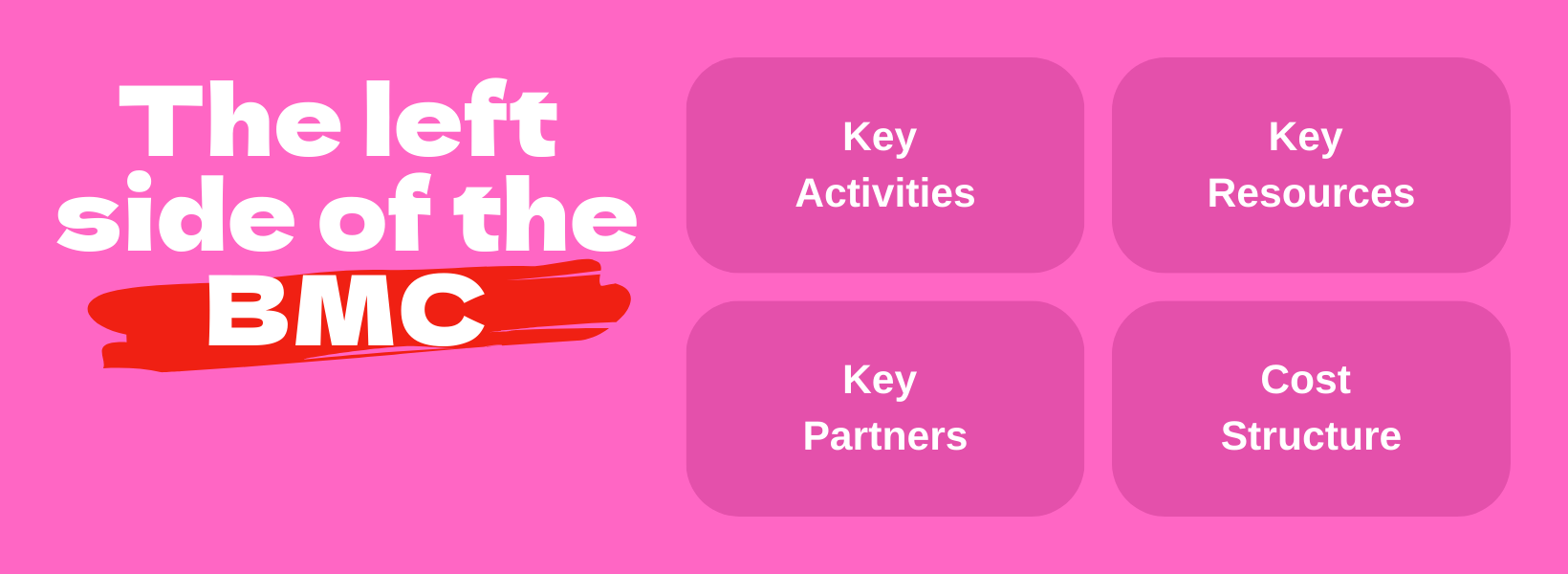
The right side of the canvas represents external factors and things you can’t influence directly like your Customer Segments, Customer Relationships, Distribution Channels, and Revenue Streams.
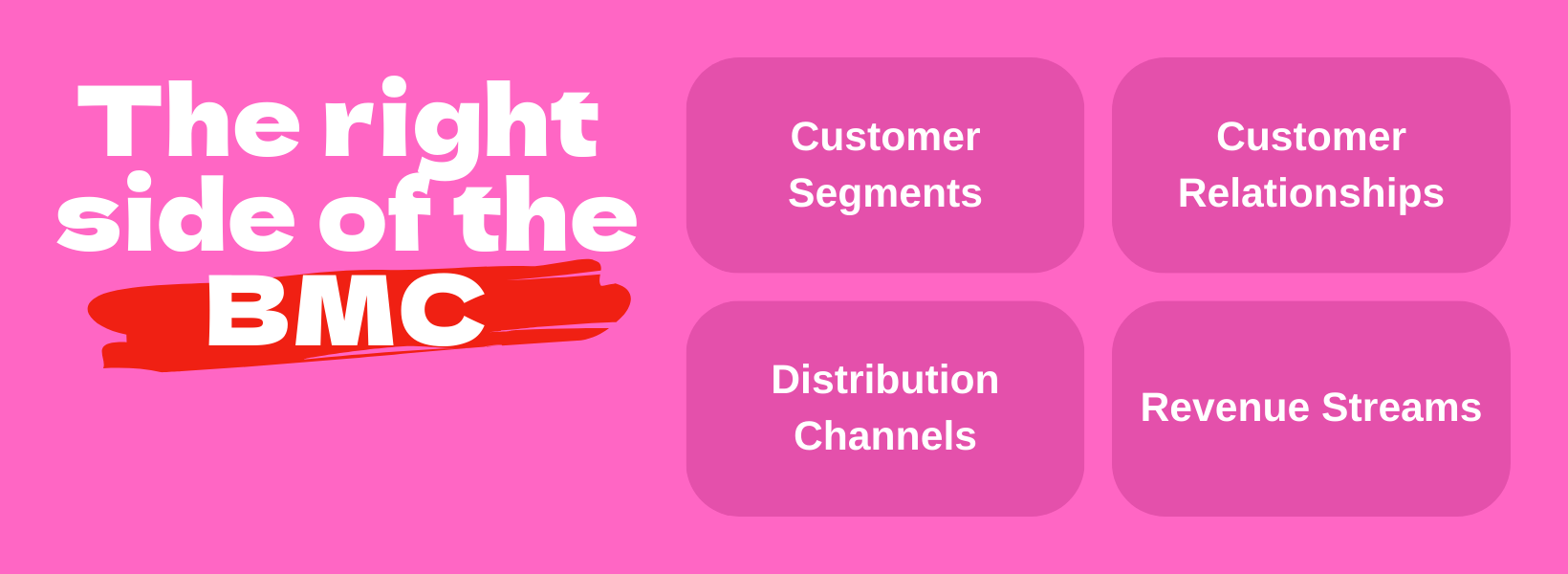
The center of the framework is the Value Proposition, which serves as an exchange point between your business and your customers.
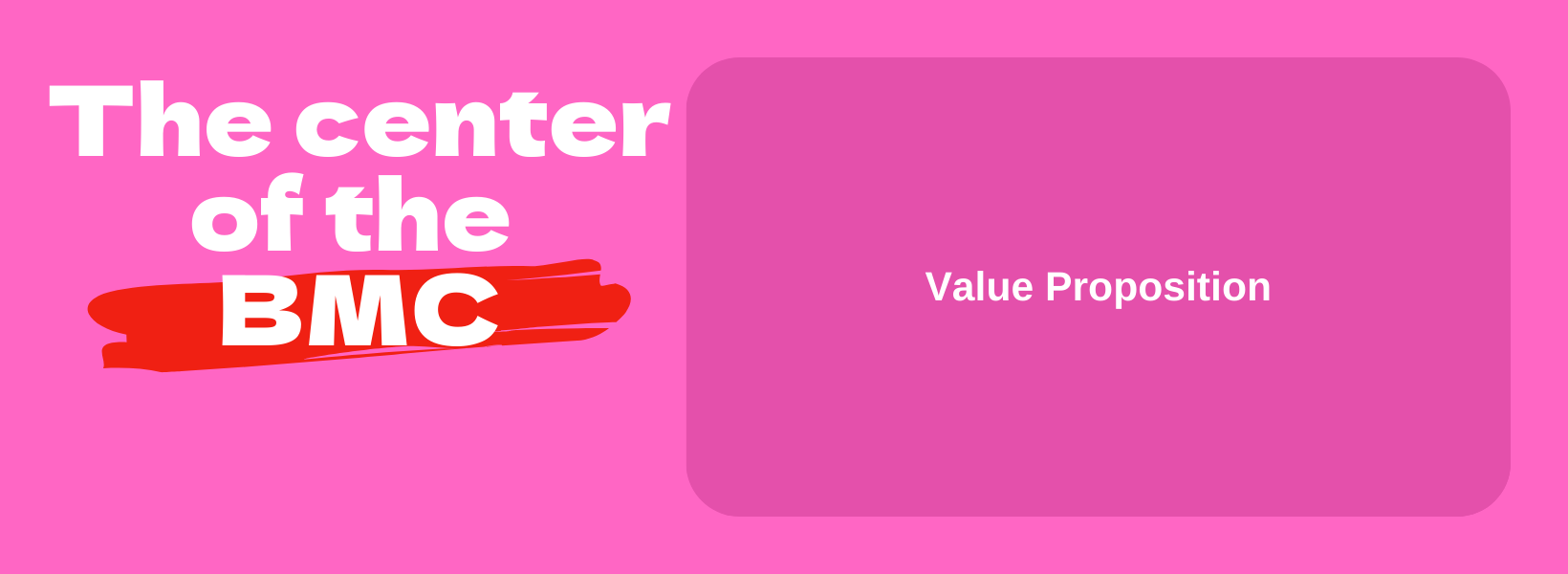
The very process of filling out this framework will help you conduct research on each aspect of your business. All the collected data can serve as an excellent pitch template to find a co-founder to help you build an MVP or find a mentor who could help you pinpoint the strengths and weaknesses of your business or even attract investors. However, if you can't fill everything in at the moment, don't feel discouraged: you are not the only one. The idea is to give it your best educated guess and move on. By moving on we mean testing and validating.
We advise that you create several copies of the canvas and update them every x days/weeks. This way you don't lose the previous information and can always go back, but at the same time your canvas does not look too crowded and messy.
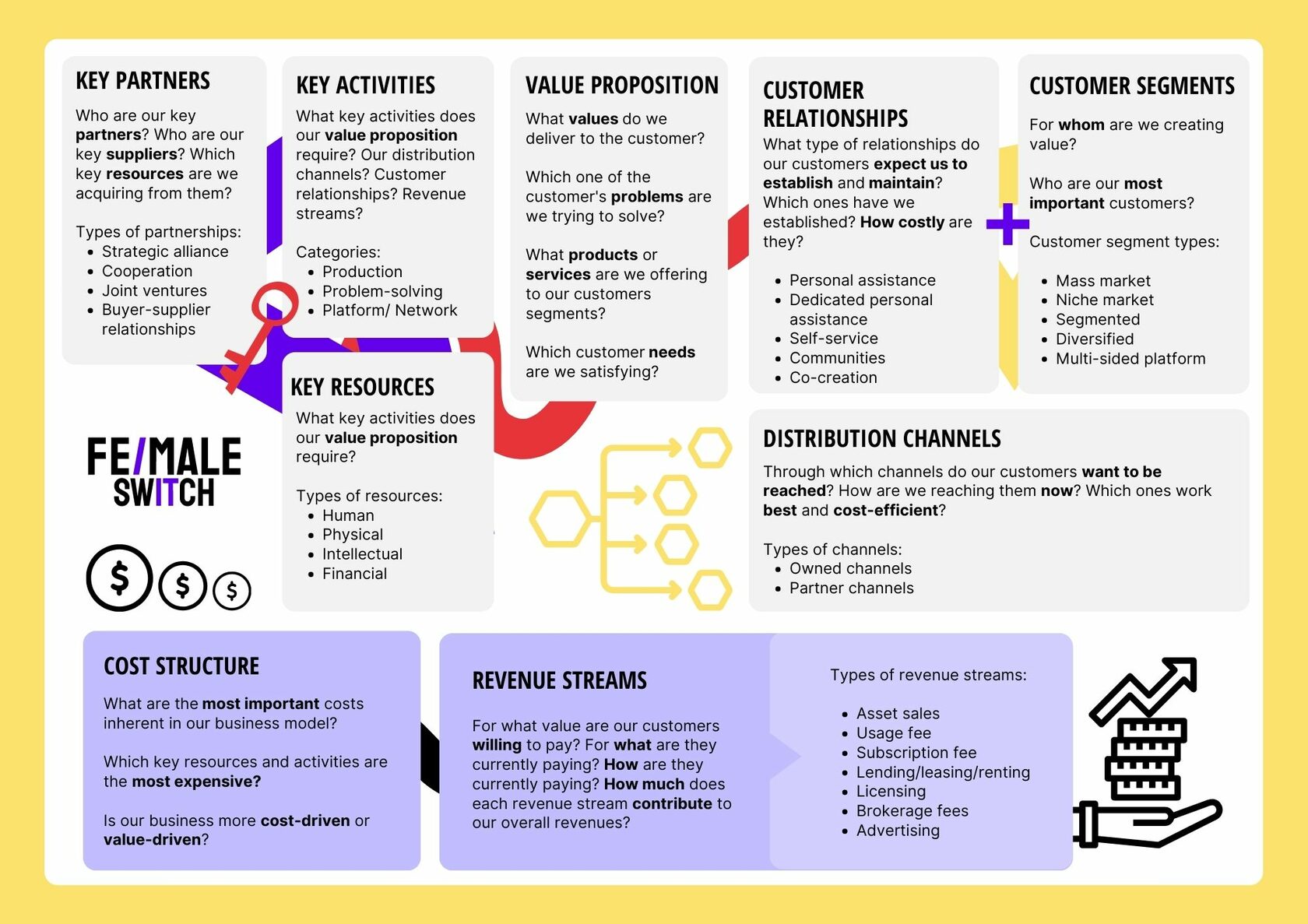
How to fill in a business model canvas?
The first step in filling in the Business Model Canvas is to identify the customer segments. This is done by researching the target market and understanding the needs of the customer. Once the customer segments are identified, the value proposition can be created. This is the unique value that the company offers to the customer. Next, the channels should be identified. These are the ways in which the company will reach its customers. The customer relationships should also be identified. This is the type of relationship the company will have with its customers. Once the customer segments, value proposition, and channels have been identified, the revenue streams should be identified. This is the way in which the company will generate revenue. The key resources, key activities, and key partners should also be identified. These are the resources, activities, and partners that are necessary to make the business model successful. Finally, the cost structure should be identified. This is the way in which the company will pay for the resources, activities, and partners that are necessary to make the business model successful.
Let’s dive deeper into what the nine building blocks of the BMC are and how to fill them in properly. This information will help you better understand your business and become an excellent template for a pitch deck in the future.
Customer segments
Customer segments are basically groups of people and companies you are trying to reach out to. Look for similarities like age, gender, user behavior, geographical area, interests, and other relevant things.
Depending on your business model, you may target a specific niche, mass market, or even customers with very different needs.
After you have done your research, create a customer persona for each segment. This will help you better understand your customers' pains and customize your approach to create perfect marketing campaigns.
Need help with figuring out your target customer and building the audience? Join our startup school.
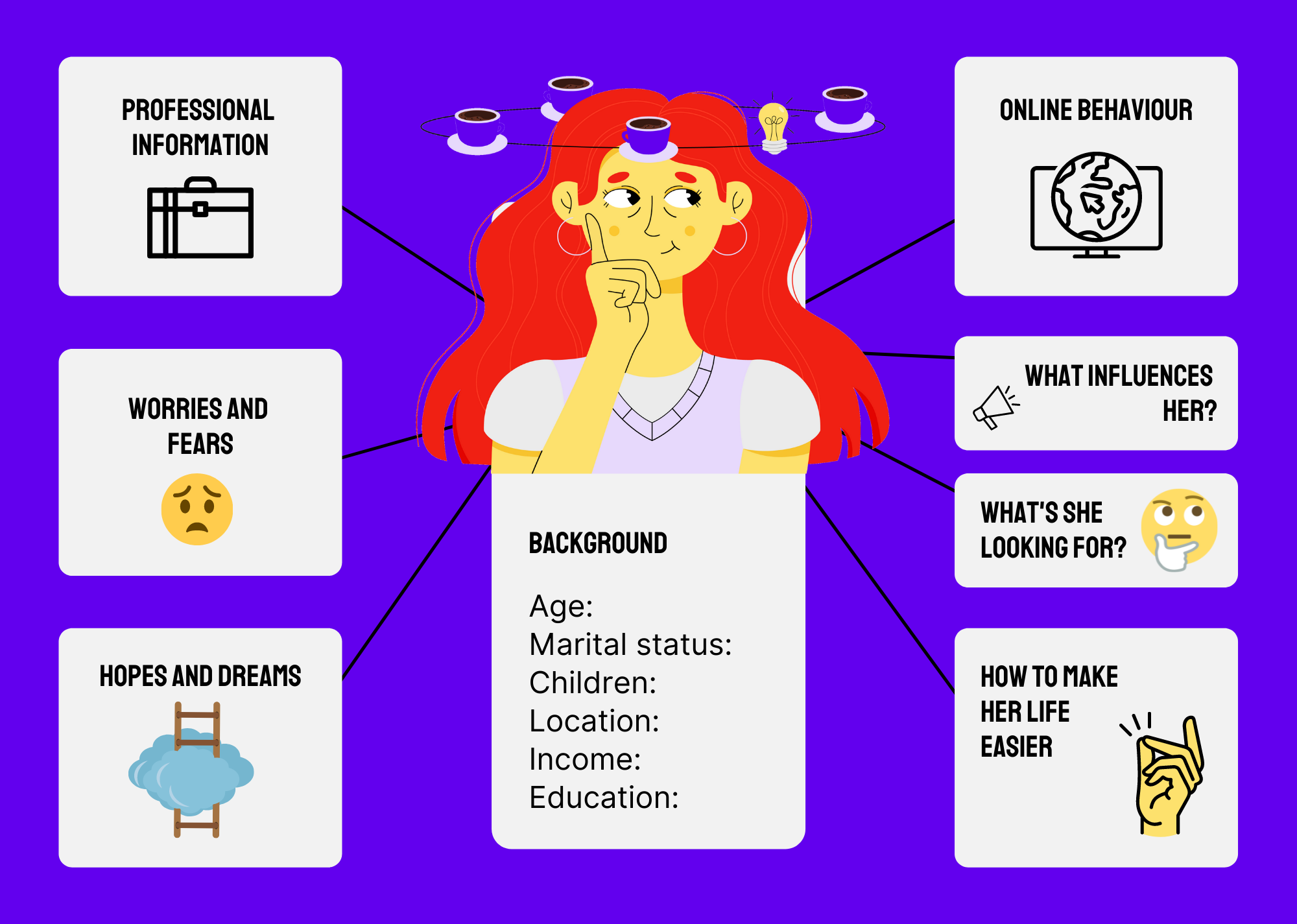
Are you interested in incubators and funding in the Netherlands or Malta? Do you want to relocate your startup to Europe or are looking to establish a company here and get funded? Check out out completely FREE module about Startups in Malta and the Netherlands where you can learn about setting up a company and getting funded. Sign up for the free startup school and navigate to "Startups in Malta" module by typing "Malta" in the search or "Startups in the Netherlands" module by typing "Netherlands" in the search.
Customer relationships
The customer relationships section of your business canvas represents how you are going to interact with different customer segments on their journey with your company.
There are several ways you can arrange this interaction. Some companies choose a more personal approach and communicate with their customers directly via social media, newsletters, forums, or any other means.
Other businesses prefer not to interact with their customers directly and offer self-service. In this case, companies provide their customers with some sort of user guides and/or a slew of automated services to perform all interactions with products by themselves.
Communities also serve as an effective channel of communication with the public. People can give feedback on your products, exchange opinions, or help each other to solve their problems on their own.
Sometimes companies engage in co-creation with their clients and give them the freedom to create content for their audience, like social media. We ourselves love co-creation and are building the startup game together with our users.
Creating a customer journey map in addition to your business model canvas will help you better understand the stages your clients go through while interacting with your business.
Distribution channels
The distribution channels section describes the means by which your company connects with the customers. Although there is a word “distribution” in the name of this section, the true purpose behind it is not only to deliver your value propositions, but to spread the word about your company and raise brand awareness.
The company may use its owned channels (a website, social media, newsletter, etc.) or act through partner channels (marketplaces, partner websites, retail, etc.).
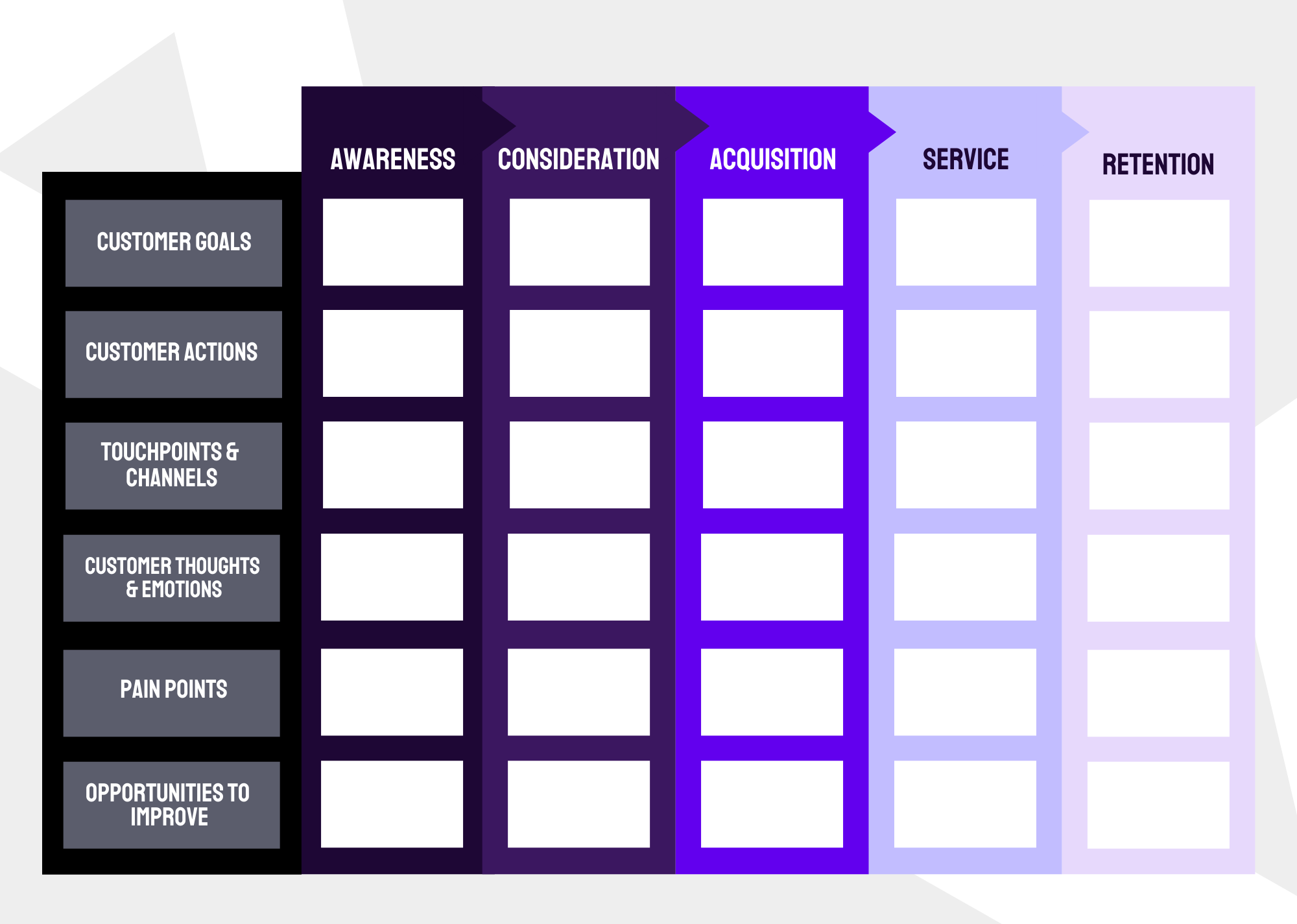
Revenue streams
The revenue streams section is responsible for sales and represents sources from which your company generates money. The model of revenue stream can be either transaction-based made from single-time payment or recurring made from ongoing payments from subscription or post-sale services. Have you ever heard about MRR or ARR? Well, that's the recurring revenue.
Your business can stream revenues not only from selling the right of ownership for a product (asset sales) but also for providing this right for a limited time (leasing or renting), as well as by charging for single-time use (usage fee) or on a regular basis (subscription fee). You might have heard about SaaS in connection to this.
You can also charge customers for permission (licensing) to use your intellectual property, acting as an intermediary (brokerage fees) between parties, or allowing them to promote their products on your platform (advertising). How do you know which to choose? Well, the answer is simple and hard at the same time: one must test to know the truth.
Key activities
The key activities section must be filled with tasks your company needs to perform to achieve its business goals.
Those activities must include fulfilling your company’s value proposition, delivering it to all customer segments, maintaining relationships with your customers, and, of course, generating income. Show me the money!
There are three general categories which are:
- Production - when a company manufactures and delivers a product.
- Problem-solving - offering a new solution to a customer’s pain.
- Platform - developing and maintaining platforms that will support third-party products.

Key resources
The key resources section represents the resources you need to perform key activities, in order to deliver your value proposition.
There are four main types of resources:
- Human - your employees and you
- Financial - investments, grants, cash, lines of credit, etc.
- Physical - inventory, buildings, machinery, any other equipment.
- Intellectual - your company’s brand, patents, IP, copyright, etc.

Key partners
In the Key partners section, you should put all your suppliers and other external companies helping you carry out the key activities. Forge partnerships to acquire necessary resources and reduce potential risks. Don't do it too early though, as getting rid of a bad partner is not a fun thing to do.
There can be several types of partnerships including:
- Joint venture - when partners develop a new business together.
- Strategic alliance - when non-competitors form a partnership to strengthen their positions.
- Buyer-supplier relationship - when one company provides the other with resources to carry out its key activities.

Cost structure
The cost structure section will help you identify what it takes to operate your business. Examine the costs of creating and distributing your value proposition, maintaining customer relationships, and creating revenue streams.
Your company may either focus on minimizing costs or providing maximum value in the selected price range.
Value proposition
At the heart of your business model rests the value proposition. It represents the product or service you want to deliver to your customers that creates value for them or solves one of their problems.
It can be either quantitative (better price and speed of service) or qualitative (new customer experience or superior design).
To succeed, you should deliver a value proposition that is either unique or different from those offered by your competitors. When offering a new product, make sure it is innovative and disruptive either in technology or its business model. If you attempt to enter the market with a product that already exists, make sure it stands out among competitors, with new features and attributes. Branding is key to success here.
Business Model Canvas template
Now you can start filling in your own Business Model Canvas with our editable Business Model tool template#nbsp. The first version will most definitely suck because you simply don't have enough reliable and verifiable data to come up with quality answers. What to do? First, calm down and drink some water. Second, you have a few options: you can fill in the canvas as much as possible and put it aside for a while. You can also try filling in a different canvas first. For example, the value proposition or the problem statement ones will get you close to answering the questions that are important for the business model.
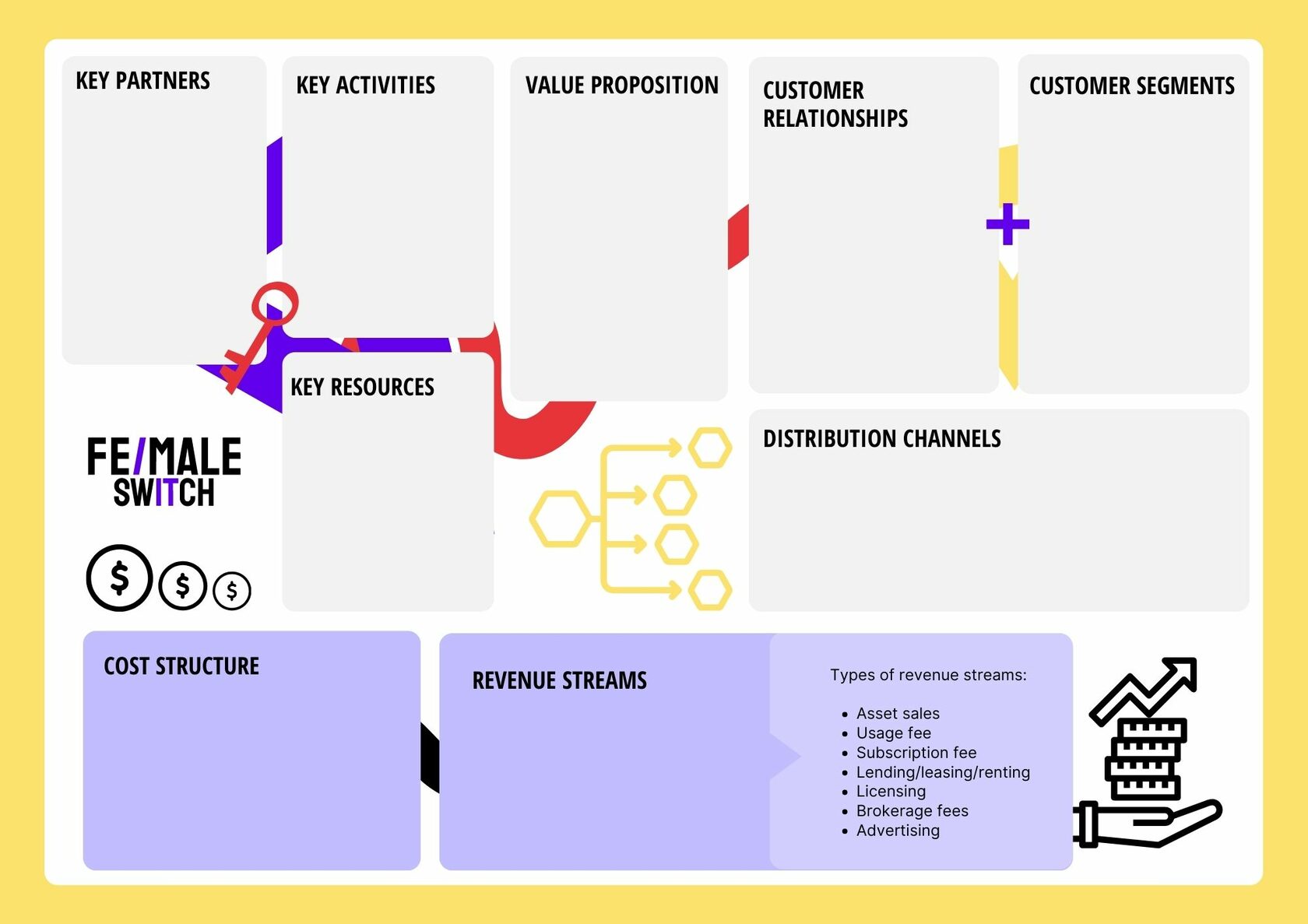
Business Model Canvas for early stage businesses
Dealing with the Business Model Canvas may be a challenge when you are in the very beginning of your startup journey. This is because BMC does not fit for very early stage businesses. You need to first think about who are you as an entrepreneur, what your target audience is going to be like, what is it that you want to build, and other fundamental questions that you already need to have answers to before you start with the Business Model Canvas.
This is why we developed the FMS Canvas for early stage startups. It will steer you towards thinking about your business idea and aligning your goals and your passion.
Get your editable template of FMS Canvas here. Create a free Canva account and start filling it in. Btw, you are going to love Canva. It's one of the best tools that you will use as a startup founder.
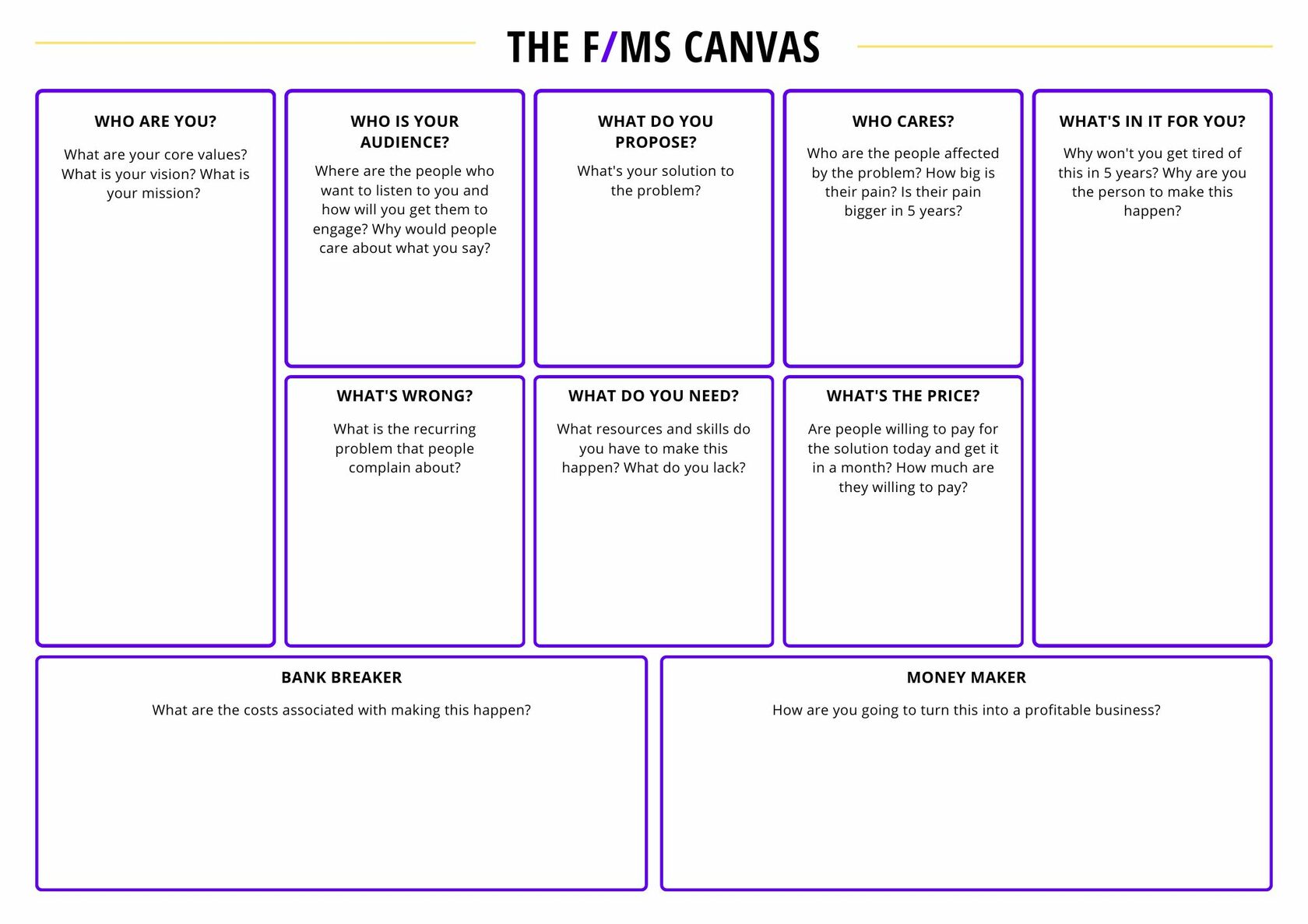
Join Fe/male Switch startup game for women to learn more
This is a tiny bit of startup knowledge that Fe/male Switch startup game features. If you want to learn much more about how to build your startup, meet other female founders, mentors, investors, play and have fun, apply for the official launch of the game.
By the way, have you already tried our GPT-4 AI BMC tool to help you come up with a draft version of your BMC? It's super neat and saves a lot of time. Here's what AI proposed when we prompted it to help us create a BMC for our startup game for women:
Key Partners:
- Game developers
- Investors
- Incubators/accelerators
- Mentors/experts in entrepreneurship
Key Activities:
- Game development and design
- Content creation
- Marketing and user acquisition
- Community building
- Partnership and networking
Key Resources:
- Game development platform and tools
- Content creation tools and resources
- Marketing and user acquisition budget
- Community management tools
- Network of partners and mentors
Value Proposition:
- Provides a fun and engaging way for women to learn about entrepreneurship and startup building
- Offers a diverse range of resources and support, including mentorship and networking opportunities
- Allows players to experiment with different business ideas and strategies in a low-risk environment
Customer Segments:
- Women interested in entrepreneurship and startup building
- Women seeking to develop their business skills and knowledge
- Women looking for mentorship and networking opportunities
Channels:
- Browser-based game
- Social media
- Online advertising
- Referral marketing
Customer Relationships:
- Community building and engagement
- Personalized support and mentorship
- Ongoing updates and new content
Revenue Streams:
- In-game purchases
- Subscription-based access to premium content and resources
- Sponsorship and advertising deals
Cost Structure:
- Game development and design
- Content creation
- Marketing and user acquisition
- Community management
- Partnership and networking costs
Ready to embark on a thrilling entrepreneurial adventure, but feeling a tad overwhelmed with everything that goes into building a successful startup? Fear not, for Elona Musk, is here to introduce you to some fantastic AI tools that'll help you conquer the startup world 🚀 Think of them as your personal army of AI minions, ready to help you at every step of your journey.
1. **Annie** - The Ultimate Product Description Tool 📝
Why struggle to find the right words for your product descriptions when Annie can magically conjure up stunning descriptions that will make your customers want to buy your product immediately? She's fast, clever, and the ultimate solution to all your product description needs! Give it a try today.
2. **Aiden** - Your Creative Startup Naming Guru 💡
Say goodbye to boring and uninspired startup names! With Aiden, you can generate the most unique and catchy names in a fraction of the time it would take you to brainstorm them. Impress your friends and colleagues with your clever choice of name, and let Aiden do the heavy lifting for you.
3. **Little Sister** - The Idea Generating Genius 🧠
Welcome Little Sister into your life, and say goodbye to staring at a blank page! As your ultimate idea-generating machine, Little Sister will revolutionize the way you come up with startup ideas, thereby making your entrepreneurial journey more exciting and fun.
4. **Boris** - The Pixel-Pushing Logo Creator 🎨
Bid farewell to mediocre logos! With Boris, our AI-based logo tool, you don't have to worry about design skills anymore. Provide well-crafted prompts and let Boris create the perfect-ish logo you've always dreamed of. Finish up the design by giving it a human touch on Canva (and remove the weird-looking text that AI loves to generate), blending the best of artificial intelligence and human creativity!
5. **Elona** - Your Startup Expert Consultant 🧐
Got questions related to startups and entrepreneurship? Look no further! As an AI startup expert tool, Elona Musk, offers you answers and valuable advice related to anything and everything regarding startups, ensuring you have a smooth sail to the finish line. Remember, happy entrepreneurship and zero code is her mantra!
So, fellow startup soldiers, don't hold back any longer—unleash the power of these AI tools TODAY and embark on your entrepreneurial journey with confidence! Happy startup-ing, and may the AI be with you! ✨
Remember: AI tools never argue and never ask for equity. Go ahead, give them a try, and see how they enrich your startup journey! 🌟
FAQ: Understanding the Business Model Canvas
1. What is the Business Model Canvas?
The Business Model Canvas is a strategic management tool designed to help develop new business models and document existing ones. It offers a visual chart with elements describing a firm's value proposition, infrastructure, customers, and finances, facilitating companies to align their activities by illustrating potential trade-offs.2. What are key activities in the Business Model Canvas?
Key activities are the most important actions a company must take to operate successfully. These include production, problem-solving, and platform/network maintenance. They are crucial for creating and delivering the product or service, maintaining customer relationships, and generating revenue streams.3. Who are key partners in the Business Model Canvas?
Key partners are external companies or individuals who contribute to the business's success. They can include suppliers, manufacturers, business allies, or any other entity that helps reduce risks or acquire resources. Collaboration with key partners allows companies to focus on their core activities while leveraging outside expertise and resources.4. Can you give an example of key partners in the Business Model Canvas?
Yes, a software development company might partner with cloud service providers for hosting their applications, with freelance developers for additional coding expertise, and with marketing agencies to promote their products. These partnerships help the company deliver more value to its customers by leveraging external expertise.5. What are key partnerships in the Business Model Canvas?
Key partnerships refer to the network of suppliers and partners that make the business model work. These relationships can be motivated by various factors such as risk reduction, acquiring particular resources, or optimizing operations. They are tailored to complement the company's internal resources and capabilities.6. What are key resources in the Business Model Canvas?
Key resources are the assets required to offer and deliver the previously described elements, such as Value Propositions, reach markets, maintain customer relationships, and earn revenues. They can be physical, financial, intellectual, or human and are essential for the company to create and offer a value proposition.7. What do Key Partners contribute to the Business Model Canvas?
Key partners contribute various resources or perform activities outside the company's core competencies. This can include offering expertise, enabling access to new markets, sharing resources to reduce costs, or contributing to product development and innovation, ultimately supporting the company's value proposition and operational efficiency.8. What is the significance of understanding each component of the Business Model Canvas?
Understanding each component, like key activities, key resources, and key partnerships, provides a holistic view of how a business operates, delivers value, and generates revenue. It helps in identifying potential strengths, weaknesses, opportunities, and threats, thus enabling better strategic planning, innovation, and competitive advantage in the marketplace.Do you want to test your startup journey without risking to fail in real life and learn essential startup knowledge, sign up for Fe/male Switch startup game for women and build your virtual startup, play, learn and fail in the game to make it right in the reality.
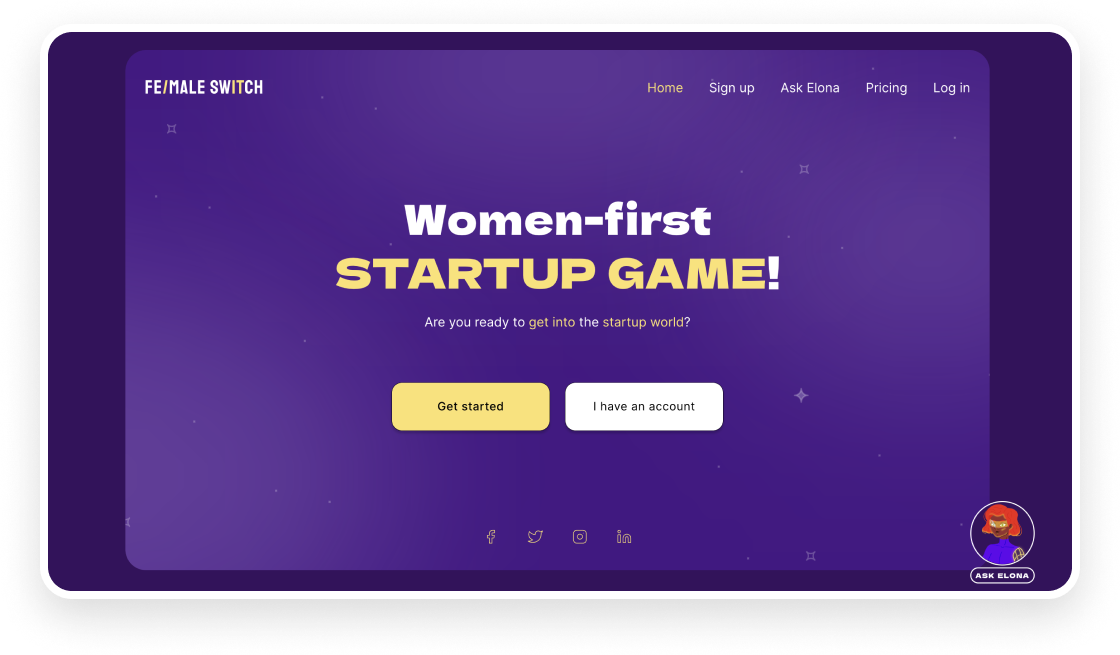
Also, we have a completely FREE STARTUP SCHOOL where you can learn about all things related to founding a startup. Sign up for the free startup school and get started immediately.
